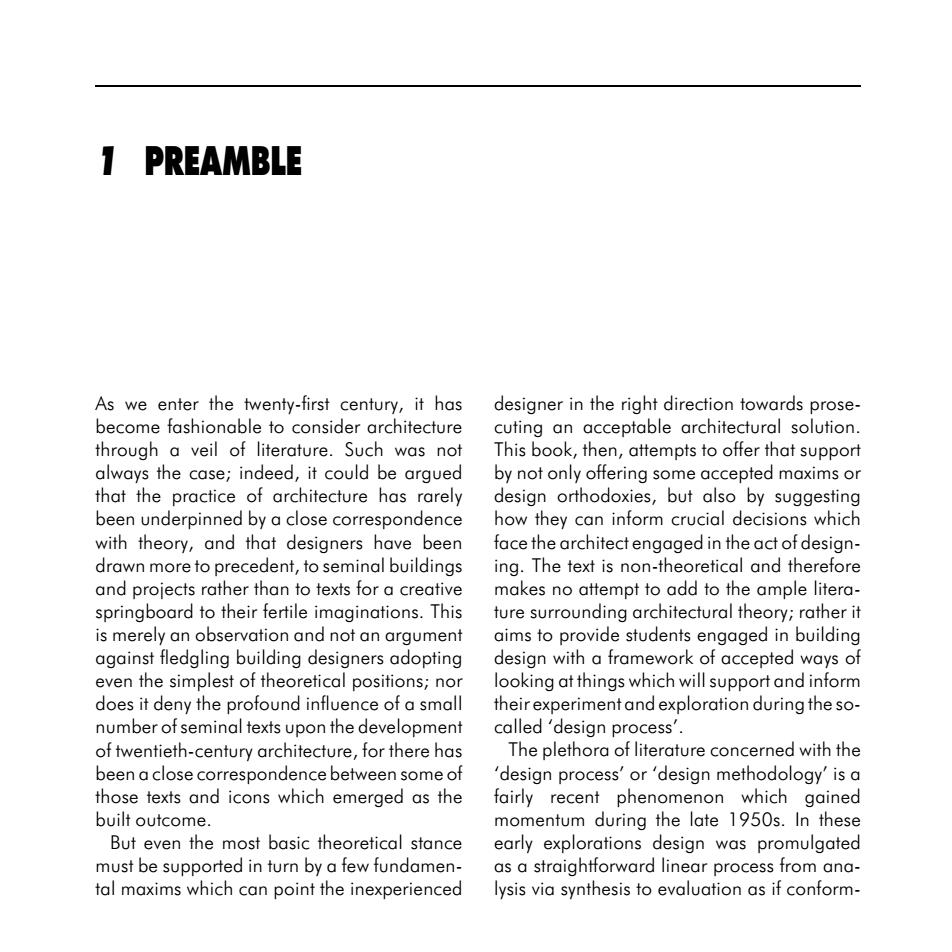正在加载图片...

1 PREAMBLE As we enter the twenty-first century,it has designer in the right direction towards prose- become fashionable to consider architecture cuting an acceptable architectural solution. through a veil of literature.Such was not This book,then,attempts to offer that support always the case;indeed,it could be argued by not only offering some accepted maxims or that the practice of architecture has rarely design orthodoxies,but also by suggesting been underpinned by a close correspondence how they can inform crucial decisions which with theory,and that designers have been face the architect engaged in the act of design- drawn more to precedent,to seminal buildings ing.The text is non-theoretical and therefore and projects rather than to texts for a creative makes no attempt to add to the ample litera- springboard to their fertile imaginations.This ture surrounding architectural theory;rather it is merely an observation and not an argument aims to provide students engaged in building against fledgling building designers adopting design with a framework of accepted ways of even the simplest of theoretical positions;nor looking at things which will support and inform does it deny the profound influence of a small their experiment and exploration during the so- number of seminal texts upon the development called 'design process'. of twentieth-century architecture,for there has The plethora of literature concerned with the been a close correspondence between some of 'design process'or'design methodology'is a those texts and icons which emerged as the fairly recent phenomenon which gained built outcome. momentum during the late 1950s.In these But even the most basic theoretical stance early explorations design was promulgated must be supported in turn by a few fundamen- as a straightforward linear process from ana- tal maxims which can point the inexperienced lysis via synthesis to evaluation as if conform-1 PREAMBLE As we enter the twenty-first century, it has become fashionable to consider architecture through a veil of literature. Such was not always the case; indeed, it could be argued that the practice of architecture has rarely been underpinned by a close correspondence with theory, and that designers have been drawn more to precedent, to seminal buildings and projects rather than to texts for a creative springboard to their fertile imaginations. This is merely an observation and not an argument against fledgling building designers adopting even the simplest of theoretical positions; nor does it deny the profound influence of a small number of seminal texts upon the development of twentieth-century architecture, for there has been a close correspondence between some of those texts and icons which emerged as the built outcome. But even the most basic theoretical stance must be supported in turn by a few fundamental maxims which can point the inexperienced designer in the right direction towards prosecuting an acceptable architectural solution. This book, then, attempts to offer that support by not only offering some accepted maxims or design orthodoxies, but also by suggesting how they can inform crucial decisions which face the architect engaged in the act of designing. The text is non-theoretical and therefore makes no attempt to add to the ample literature surrounding architectural theory; rather it aims to provide students engaged in building design with a framework of accepted ways of looking at things which will support and inform their experiment and exploration during the socalled ‘design process’. The plethora of literature concerned with the ‘design process’ or ‘design methodology’ is a fairly recent phenomenon which gained momentum during the late 1950s. In these early explorations design was promulgated as a straightforward linear process from analysis via synthesis to evaluation as if conform-